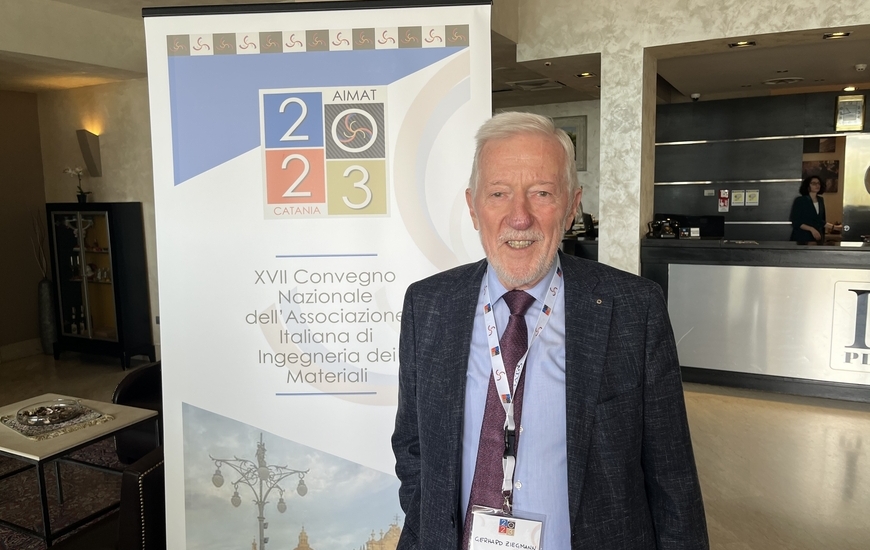by NICOLA CATENARO
On the occasion of the national conference of AIMAT - the Italian Association of Materials Engineering - in Catania, at the Plaza Hotel, from 28 May to 1 June, we interviewed Professor Gerhard Ziegmann* on new technologies for the serial production of composite components which he developed during his latest research.
Professor Ziegmann, let's talk about this new process, this new machine for serial production you realized. What are we talking about?
«Well, it's a new machine, which is using a process which is well-known in principle, but it is turning the sequence of processing. You know, normally the so-called prepreg process means that a textile structure, carbon fiber or glass fibers is produced online. And then at the end user or the manufacturer, the structure is cut out, out of a continuous prepreglayer. And by complicated shapes, you get about, let's say, between 20 and 30% of scrap. That scrap is already impregnated with epoxy system, which means recycling of that scrap is very expensive or nearly impossible. And now we want to turn that process steps in a different way, that we are cutting off the dry fiber into the final shape of the structure. And we are only impregnating very precise that dry textile layer which is cut out. So it means the dry fiber or the scrap of the dry fiber can be recycled quite easily because it's a dry fiber and you can recycle it using the performance of the recycled fibers to an extreme high degree. For instance, you can spin a continuous yarn again, and by impregnating only that structure, we reduce the amount of scrap for epoxy systems down to, let's say 5% - that's one aspect. The other aspect is that - by that process - we can select the epoxy or any kind of system in a way related to the process, related to the speed of the process in order to improve the speed and the processability within that technology».
Which field do you think will be the first field in which we could make these applications?
«I think one field would be automotive industry, but let's say automotive industry is quite carefully in using composites, unfortunately. That would be one aspect and the other one is for sure very interesting in sporting goods industry, let's say snowboard, ski or whatever, where you have flat structures which can be impregnated in a very easy way. And once we are going back to different textile structures, by weaving and knitting we can produce a textile structure by which we can produce directly the net shape of a snowboard, something else, and could be impregnated with that machine in a very easy and a very fast way».
Do you think that this process could be integrated in the manufacturing process of the car? So you start from the materials and you stop...
«... at the press. Yes. Our process as it is realized now with our machine is cutting directly the textile structure, transferring into the impregnation area and from there we can go on directly into the big press so we can follow the whole line. In between there is a step where, depending on the time scale, we can heat up that pre-impregnated material that the curing reaction is already going on, that the curing process in the press can be reduced by time, that the processing step could be improved and the time scale could be improved very much».
In terms of costs, time and quality, what will be the benefits?
«Let's start with the selection of material. You know, for today, when you are buying a prepegsystem, you have only the chance to select, out of a small number of resin systems which are quite expensive because they have to be stored at -20 for some months. So you need a refrigerator, you need slow curing materials. In our new process concept, we can adapt the resin systems directly to the speed of the process. So when we are saying it's a kind of a snap curing epoxy system, so we can really go down to several minutes in the complete process chain. That is one aspect. And the other aspect is, for instance, once we have thick laminates and we have to realize, for instance, high impact characteristics, then we can stack different kinds of resins layer by layer. We can use different resins which are, let's say, stiff or which are more impact resistant systems. So we can combine in different ways and optimize the structural requirements. And the third point will be thinking about the battery casing of electric cars. They have to be lightweight. They have to be impact resistant and fire resistant. Once we are filling an epoxy resin with fire resistant materials like aluminum hydroxide or something else, viscosity is improving dramatically. You cannot use that kind of resin, for instance, in high pressure RTM because it doesn't flow and the particles will be filtered. Now, when we are impregnating from top, you only have to realize the permeability in the sector of action of several millimeters. So we will not have a filtering effect and you can improve the quality regarding fire resistance or regarding impact characteristics by applying nanoparticles without filtering effect. Those are some aspects which have to be kept in mind and we have to transfer that idea, for instance, to automotive industry, sporting goods industry to show them those advantages and technical aspects, but also on the financial aspects for sure that they can improve processing speed and they can select the material combinations in a better way».
Composites will grow more than metals?
«Hopefully. You see, there are some points, you know, carbon fibers are discussed as fibers which need a high amount of energy to be produced because they have to be oxidized and carbonized at quite high temperature, around 1500°C. But when you are applying those fibers in a structure which needs a lot of energy during lifetime, for instance, a structure of a car or of a railway wagon or something else, the energy reduction by lightweight construction is dramatically high. That low amount of energy in production in comparison to steel, can be controlled quite easily by the reduction of energy during the use of that structure. Those arguments have to be transferred to industry in a better way. And that's what we are looking for. It is not easy to convince people in the automotive industry because they are convinced, that is a new technology and as long as they are happy with the technical solutions they are using now, they don't really focus on lightweight construction with new material solutions. In smaller companies, with a lower production rate like Lamborghini or Ferrari, they are going more and more in the understanding of composite materials. That could be a step where we can show that the transfer of composites into high loaded structures could be interesting. From there to a series production in BMW or Mercedes, Alfa Romeo or whatever, to transfer that will take time because to convince those engineers which are educated in metal, having built up a great experience with those material categories to transfer to composite, that is not easy and a great challenge for the near future».
* Senior Professorship Composite Materials - Institute for Polymer Materials and Plastics Engineering; Clausthal University of Technology
-

-
13 June 2023























